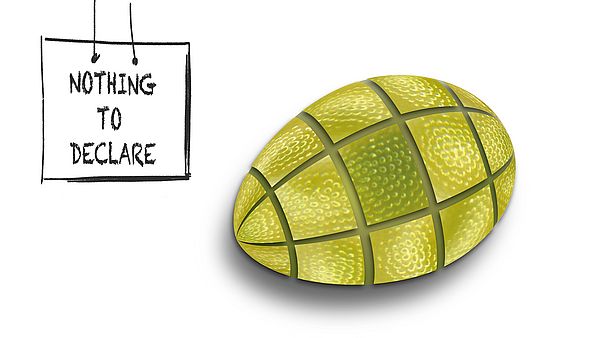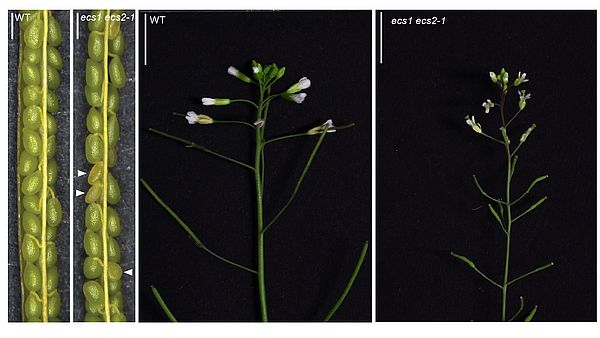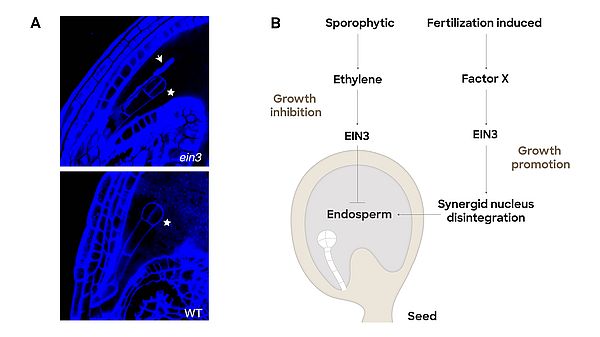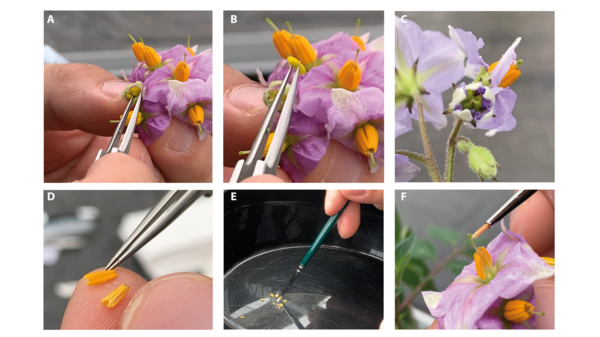Plant reproduction

Identification of 3-parent plants in the model organism Arabidopsis thaliana
It was considered an inviolable principle that sexually reproducing organisms have no more than two parents and fertilization of an egg by multiple sperm (polyspermy) is lethal in many eukaryotes. In flowering plants polyspermy has remained a hypothetical concept, due to the lack of tools to unambiguously identify and trace this event. We established a high-throughput polyspermy detection assays, which uncovered that supernumerary sperm fusion does occur in planta and can generate viable polyploid offspring. Moreover, polyspermy can give rise to seedlings with one mother and two fathers, challenging the bi-organismal concept of parentage. Our results provide direct evidence for polyspermy as a route towards polyploidy, which is considered a major plant speciation mechanism (Nakel et al. 2017, Tekleyohans, Groß-Hardt 2019).

Implications for plant breeding: 3-parent crosses can bypass a dominant hybridization barrier
The so-called triploid block is an established and widely distributed postzygotic hybridization barrier of the embryo-nourishing endosperm. We were able to show that most polyspermy-derived plants develop from seeds resulting from selective egg cell polyploidization, thereby bypassing the DNA checkpoint of the endosperm.
The economic and societal impact of our discovery is gaining pivotal importance in light of rapid worldwide changes, including global warming and a growing world population. Three parent crosses can speed up breeding processes and bypass hybridization barriers. This can revolutionize the ability of breeders to develop improved crops in providing a tool to mine beneficial gene variants of currently incompatible species and to substantially shorten time to market of climate-adapted seed varieties (Mao et al. 2020, Hater et al. 2020).

ECS1 and ECS2 regulate polyspermy and suppress the formation of haploid plants by promoting double fertilization
We identified the first molecular components to regulate polyspermy frequencies: ECS1 and ECS2 code for endopeptidases and loss-of-function is associated with a fertilization defect, supernumerary pollen tube attraction and increased polyspermy frequency. Intriguingly, ecs1 ecs2 double mutants also induce haploidy, which is an agronomically highly relevant trait (Mao et al. 2022).

EIN3 is a repressor of supernumerary pollen tube attraction and regulates seed size
In flowering plants, sperm cells are delivered by pollen tubes, which are attracted by two egg-cell-adjoining synergids. Successful fertilization terminates pollen tube attraction. We have shown that the process of fertilization activates the transcription factor EIN3, which mediates synergid cell death and the concomitant establishment of a pollen tube block (Völz et al 2012). In addition, we have uncovered dual roles of EIN3 in regulating seed size, a parameter critically affecting grain yield. Capitalizing on the analysis of multiple ethylene biosynthesis mutants, we demonstrate that EIN3 represses endosperm and seed development in a pathway regulated by ethylene. We, in addition, provided evidence that EIN3-mediated synergid nucleus disintegration promotes endosperm expansion. Whereas the growth-inhibitory ethylene-dependent EIN3 action appears to be encoded by sporophytic tissue, the growth-promoting role of EIN3 is induced by fertilization, revealing a generation conflict that converges toward the key signalling component EIN3 (Heydlauff et al 2022).

Speed Robo Breed
Robot assisted high speed breeding
Climate change requires crops that deliver high yields under extreme weather conditions. This makes it necessary to develop accelerated breeding methods that produce new varieties in a shorter time. The aim of the collaborative project with the Bock Bio Science is to use tissue culture and automation to develop a package of methods that will enable rapid generation cycles for breeding in artificial culture systems and, in the future, the reliable detection of three-parent hybrids. To this end, we will develop the basis for building a versatile platform for accelerated, automated breeding of three-parent plants on the crop Solanum (potato). New culture and polyploidization methods as well as the programming of adaptive image recognition algorithms will be developed in the project.
Contact
Dr. Thomas Nakel
nakelprotect me ?!uni-bremenprotect me ?!.de
phone: +49 421 218 50202




